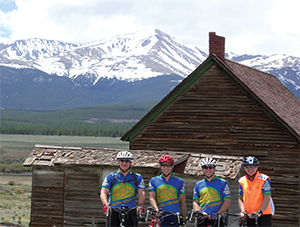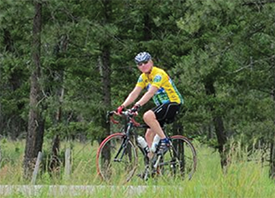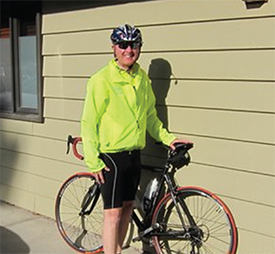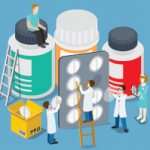
Dr. Weinblatt (orange vest) rode through Colorado with his fellows from the Waban Young Men’s Pedaling Society.
Bonus: Listen to excerpts from our conversation with Dr. Weinblatt.
Michael Weinblatt, MD, is the co-director of clinical rheumatology at Brigham and Women’s Hospital in Boston, a professor of medicine at Harvard Medical School, past president of the American College of Rheumatology, and co-director of the ACR Winter Rheumatology Symposium at Snowmass, Colo.
Those are some pretty impressive credentials, but nothing appears to make him smile more than his affiliation with another organization—the WYMPS (Waban Young Men’s Pedaling Society).
Since 1990, Dr. Weinblatt, now 65 years old, has been an active member of WYMPS, which is composed of a dozen bicycling enthusiasts, some of whom are doctors. Many have ridden together across the country twice, seen more cities than most people have ever heard of and visited such popular destinations as Glacier National Park, Yellowstone and Mt. Ranier. Every summer, the group picks a new or favorite spot and explores America. Except for practicing medicine, Dr. Weinblatt can’t envision a better way of spending his time.
Bicycling Ranger
During Dr. Weinblatt’s junior and senior years in college and his first two years at the University of Maryland School of Medicine, he worked summers as a park ranger at Yellowstone National Park.
“I was an interpretive specialist or naturalist,” he says. “I gave hikes, talks and did some environmental impact research.”
He also bicycled all around Geyser Basin (Old Faithful) and along the park’s paved roads. He earned the distinction of being one of the park’s bicycle rangers.
After he graduated medical school in 1975, other demands were placed on his time. He completed his internship and residency in internal medicine at the University of Maryland Hospital and then pursued his fellowship in rheumatology at Robert Brigham Hospital (now the Brigham and Women’s Hospital, which is affiliated with Harvard Medical School) in Boston between 1978 and 1980.
Nearly a decade later, in 1989, he met two neighbors who were bicyclists. Weather permitting, they started riding about 15 miles each weekday and 25–50 miles every Saturday and Sunday.
The small group grew to five men—all neighbors—who nicknamed themselves the WYMPS. They established a tradition that is still upheld today. The group meets every morning at Starbucks—whether they ride or not—to grab a cup of coffee and chat about family, jobs and whatever else is on their minds. Of course, he adds, “None of this would be possible without the full support of our spouses and children.”
Initially, they rode around Boston and then crossed the state line into New Hampshire. Whenever they had the chance, they took two-day cycling trips to Lake Sunapee and the surrounding mountains, roughly 150 miles from Waban, their hometown.
Adventure, Charity & Lions
After four years of the same routine, the bicyclist group grew restless. In 1995, one member suggested riding across America.
Dr. Weinblatt says, “We did a point-to-point ride,” explaining that no one could take several months off from work to ride across the country. “We planned a route, flew to Oregon and rode seven to 10 days a year. Where we finished one year, we started [where we had left off] the next year.”
It took five years to ride across the country. Each day, they would bicycle between 80 and 100 miles.
The first year, he says, the group bicycled through Oregon, from Florence to the bottom of Hell’s Canyon. The second year’s route took them from Hell’s Canyon to Glacier National Park, Mt. The third year, the group rode from Missoula, Mt., to Fargo, N.D. In year four, the group bicycled from Fargo to Mandolin Island, Ontario. During the final leg of the trip, they rode from Canada by way of Niagara Falls back to Boston.
“We rented a van, put the bikes in the van and rotated drivers every hour,” he adds. “When we got to mountain passes, because all of us wanted to ride the passes, we would leave the van at the bottom of the pass. Whoever got up to the pass first would ride back down and drive the van back up.”
This first ride was a charity ride. One of the group’s members was a gastroenterologist who was honored by the Crohn’s and Colitis Foundation of America. The bicyclists raised money in his name, mainly from friends and neighbors, persuading them to donate money for every mile they rode.
After completing the first ride across the country, a second cross-country trip was planned. It took seven years to complete. This time, the group followed the TransAmerica Trail, normally a several-month, 4,200-mile journey through nine states.
During both cross-country trips, the group was reminded about the potential hazards of bicycling. While riding though Colorado, Dr. Weinblatt says one bicyclist hit a rock, spun out of control, bounced off a guardrail and then bounced back into the road. “He ended up with serious road burn,” he says.
Another time, while in Washington, a bicyclist was riding downhill and spotted a mountain lion at the bottom of the hill. Fortunately, he says another bicyclist was close behind, and the animal was scared off.
Dr. Weinblatt experienced one serious accident just three blocks from his house. The front tire of his bike hit the rear tire of the bicyclist in front of him. He flew over the handlebars and dislocated his elbow. Still, he says, after bicycling thousands of miles over the past 26 years, he can’t complain.
In June, the group plans on bicycling from Jackson Hole, Wyo., through the northeast portion of Yellowstone and, then, along Beartooth Highway, a 68-mile byway nearly 11,000 feet in elevation.
A Clear Mind
“Medicine is stressful,” says Dr. Weinblatt, adding that riding relaxes him, clears his mind and enables him to think about clinical situations and research work. “When you get to go around the country on a bike, you realize how blessed you are as a rheumatologist.”
Carol Patton, a freelance writer based in Las Vegas, Nev., writes the Rheum after 5 column for The Rheumatologist.



